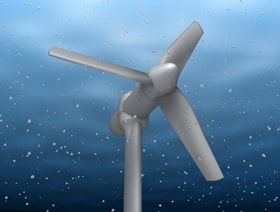
Tidal Barrage Generation
Tidal Barrages – turning the tide on power generation
![]() The Tidal Barrage or Tidal Power Plant as it is also known, is a form of “marine renewable energy” generation system that uses long walls, dams, sluice gates or tidal locks to capture and store the potential energy of the ocean.
The Tidal Barrage or Tidal Power Plant as it is also known, is a form of “marine renewable energy” generation system that uses long walls, dams, sluice gates or tidal locks to capture and store the potential energy of the ocean.
A Tidal Barrage is a type of tidal power generation scheme that involves the construction of a fairly low walled dam, known as a “tidal barrage” and hence its name, spanning across the entrance of a tidal inlet, basin or estuary creating a single enclosed tidal reservoir, similar in many respects to a hydroelectric impoundment reservoir.
The bottom of this barrage dam is located on the sea floor with the top of the tidal barrage being just above the highest level that the water can get too at the highest annual tide. The barrage has a number of underwater tunnels cut into its width allowing the sea water to flow through them in a controlled way by using “sluice gates” on their entrance and exit points. Fixed within these tunnels are huge tidal turbine generators that spin as the sea water rushes past them either to fill or empty the tidal reservoir thereby generating electricity.
The water which flows into and out of these underwater tunnels carries enormous amounts of kinetic energy and the job of the tidal barrage is to extract as much of this energy as possible which it uses to produce electricity. Tidal barrage generation using the tides is very similar to hydroelectric generation, except the water flows in two directions rather than just one.
The Ebb and Flow of Tides
On incoming high tides, the water flows in one direction and fills up the tidal reservoir with sea water. On outgoing ebbing tides, the sea water flows in the opposite direct emptying it. As a tide is the vertical movement of water, the tidal barrage generator exploits this natural rise and fall of tidal waters caused by the gravitational pull of the sun and the moon.
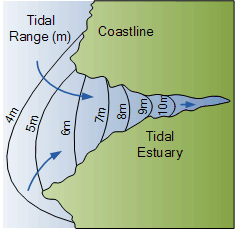
The gravitational effects of the sun or the moon on the worlds oceans causes huge amounts of sea water to be directed towards the nearest coastline. The result of this movement of water is a rise in the sea level. In the open ocean, this rise is very small as there is a large surface area with deeper depths for it to flow into.
However, as the oceans water moves nearer towards the coastline, the sea level rises steeply especially around inlets and estuaries because of the upward sloping gradient of the sea bed. The effect of this sloping gradient is to funnelling the water into the estuaries, lagoons, river inlets and other such tidal “bottlenecks” along the coastline.
The result of funnelling all of this water is that the height of the sea level once inside these inlets can increase vertically many meters every day as it is being pushed forward by the incoming sea water behind it as shown in the image. This increase in the sea level can create a tidal range of over ten meters in height in some estuaries and locations which can be exploited to generate electricity.
The tidal range is the vertical difference between the high tide sea level and the low tide sea level. The tidal energy extracted from these tides is potential energy as the tide moves in a vertical up-down direction between a low and a high tide and back to a low creating a height or head differential.
A tidal barrage generation scheme exploits this head differential to generate electricity by creating a difference in the water levels either side of a dam and then passing this water difference through the turbines. The three main tidal energy barrage schemes that use this water differential to their advantage are:
- Flood Generation: – The tidal power is generated as the water enters a tidal reservoir on the incoming Flood tide
- Ebb Generation: – The tidal power is generated as the water leaves a tidal reservoir on the Ebb flow tide
- Two-way Generation: – The tidal power is generated as the water flows in both directions in and out of the reservoir during both the Flood and the Ebb tides
Tidal Barrage Flood Generation
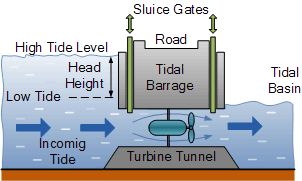
A Tidal Barrage Flood Generation uses the energy of an incoming rising tide as it moves towards the land. The tidal basin is emptied through sluice gates or lock gates located along the a section of the barrage and at low tide the basin is effectively empty.
As the tide turns and starts to comes in, the sluice gates are closed and the barrage holds back the rising sea level, creating a difference in height between the levels of water on either side of the barrage dam.
The sluice gates to the entrances to the dams tunnels can either be closed as the sea water rises to allow for a sufficient head of water to develop between the sea level and the basin level before being opened generating more kinetic energy as the water rushes through, turning the turbines as it passes. Or may remain fully open, filling up the basin more slowly and maintaining the same water level inside the basin as out in the sea.
The tidal reservoir is therefore filled up through the turbine tunnels which spin the turbines generating tidal electricity on the flood tide and is then emptied through the opened sluice or lock gates on the ebb tide. Then a flood tidal barrage scheme is a one-way tidal generation scheme on the incoming tide with tidal generation restricted to about 6 hours per tidal cycle as the basin fills up.
The movement of the water through the tunnels as the tidal basin fills up can be a slow process, so low speed turbines are used to generate the electrical power. This slow filling cycle allows for fish or other sea life to enter the enclosed basin without danger from the otherwise fast rotating turbine blades. Once the tidal basin is full of water at high tide, all the sluice gates are opened allowing all the trapped water behind the dam to return back to the ocean or sea as it ebbs away.
Flood generator tidal power generates electricity on a incoming or flood tide, but this form of tidal energy generation is generally much less efficient than generating electricity as the tidal basin empties, called “Ebb Generation”.
This is because the amount of kinetic energy contained in the lower half of the basin in which flood generation operates is much less the kinetic energy present in the upper half of the basin in which ebb generation operates due to the effects of gravity and the secondary filling of the basin from inland rivers and streams connected to it via the land.
Tidal Barrage Ebb Generation
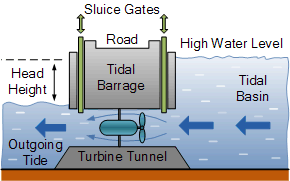
A Tidal Barrage Ebb Generation uses the energy of an outgoing or falling tide, referred to as the “ebb tide”, as it returns back to the sea making it the opposite of the previous flood tidal barrage scheme.
At low tide, all the sluice and lock gates along the barrage are fully opened allowing the tidal basin to fill up slowly at a rate determined by the incoming flood tide.
When the ocean or sea level feeding the basin reaches its highest point at high tide, all the sluices and lock gates are then closed entrapping the water inside the tidal basin (reservoir). This reservoir of water may continue to fill-up due to inland rivers and streams connected to it from the land.
As the level of the ocean outside the reservoir drops on the outgoing tide towards its low tide mark, a difference between the higher level of the entrapped water inside the tidal reservoir and the actual sea level outside now exists. This difference in vertical height between the high level mark and the low mark is known as the “head height”.
At some time after the beginning of the ebb tide, the difference in the head height across the tidal barrage between the water inside the tidal reservoir and the falling tide level outside becomes sufficiently large enough to start the electrical generation process and the sluice gates connected to the turbine tunnels are opened allowing the water to flow.
When the closed sluice gates are opened, the trapped potential energy of the water inside flows back out to the sea under the enormous force of both gravity and the weight of the water in the reservoir basin behind it. This rapid exit of the water through the tunnels on the outgoing tide causes the turbines to spin at a fast speed generating electrical power.
The turbines continue to generate this renewable tidal electricity until the head height between the external sea level and the internal basin is too low to drive the turbines at which point the turbines are disconnected and the sluice gates closed again to prevent the tidal basin from over draining and effecting local wildlife. At some point the incoming flood tide level will again be at a sufficient level to open all the lock gates filling-up the basin and repeating the whole generation cycle over again as shown.
Power Generation during Ebb Tide
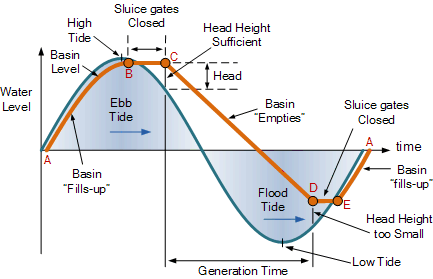
From the graph above we can see that the tidal basin fills up between points E and B via A on the incoming flood tide. Once high tide is reached, the sluice gates are then closed between points B – C to stop the tidal basin from emptying. Therefore no power is generated between points E – C while the basin is filling up.
When there is sufficient head height between either side of the barrage, the sluice gates are opened at point C releasing the trapped water back to the sea and power generation starts. The tidal basin continues to empty driving the tidal generators until the level of water in the basin reaches point D.
At point D the head height of the sea water across the barrage is no longer adequate to drive the turbines so the sluice gates are closed and generation stops until the level of the sea water reaches point E again and the whole process starts over. Then Ebb Tidal Barrage Generation also known as outgoing generation, takes its name because the electrical generation only occurs as the tide ebbs or flows out.
At point E the sea level becomes sufficient to re-fill the basin and the sluice gates are opened. Therefore, the tidal reservoir is filled up through the sluice or lock gates on the flood tide and is emptied through the turbine tunnels which spin the turbines generating tidal electricity on the ebb tide. Then an ebb tidal barrage scheme is a one-way tidal generation scheme which operates between points C – D on the graph above.
Two-way Tidal Barrage Generation Scheme
We have seen above that both Flood Tidal Barrage and Ebb Tidal Barrage installations are “one-way” tidal generation schemes, but in order to increase the power generation time and therefore improve efficiency, we can use special double effect turbines that generate power in both directions. A Two-way Tidal Barrage Scheme uses the energy over parts of both the rising tide and the falling tide to generate electricity.
Two-way electrical generation requires a more accurate control of the sluice gates keeping them closed until the differential head height is sufficient in either direction before being opened. As the tide ebbs and flows, sea water flows in or out of the tidal reservoir through the same gate system. This flow of tidal water back and forth causes the turbine generators located within the tunnel to rotate in both directions producing electricity.
However, this two-way generation is in general less efficient than one-way flood or ebb generation as the required head height is much smaller which reduces the period over which normal one-way generation might have otherwise occurred. Also, bi-directional tidal turbine generators designed to operate in both directions are generally more expensive and less efficient than dedicated uni-directional tidal generators.
One way of improving the operating time and efficiency of a two-way tidal barrage scheme is to use individual one-way uni-directional tidal turbines inverted along the barrage. By controlling their individual sluice gates, one set of turbines can be made to operate on the flood tide between points E - B and the other set operate on the ebb tide between points C - D. While this method increases the total number of tidal turbines located along the tidal barrage, it has the advantage that the generation period is greatly extended.
Tidal Barrage Generation Summary
We have seen that the amount of energy available for extraction by a Tidal Barrage Generation scheme is approximately proportional to the square of the tidal range, in other words the head squared, ( H2 ). Then it is important to select a site which has a good power generation capacity, that is it has a good vertical head height as the amount of power generated is related to the volume of water which can pass through the turbines.
Furthermore, the electricity produced from a tidal barrage generation schemes is determined by the periods that generation can take place, every twelve hours as the tide ebbs and flows. Therefore there will be no tidal power generated at the six-hour mark in between and during stationary high and low tide times. Also, since the actual time of the high tide advances about one hour each day, the supply of electricity from a tidal barrage generating scheme may, therefore, not match the hourly or daily peak time requirements of the electricity demand.
In the next tutorial about Tidal Energy we will look at another form of tidal power generation called Tidal Stream which uses the kinetic energy of tidal currents flowing in the seas to rotate underwater turbines.
For more information about “Tidal Barrage” systems and how to generate your own electricity using the tidal energy from the sea, or obtain more tidal energy information about the various tidal energy systems available around the world, or to just explore the advantages and disadvantages of tidal power, then why not Click Here to order your copy from Amazon today about ocean, tidal and wave energy, the energy revolution from the sea.











Interesting read about Tidal Barrage and Tidal Barrage Energy Devices! It’s incredible to think that this technology could provide a consistent and renewable source of energy. I look forward to seeing how it develops and the potential impact it could have on the environment and our energy infrastructure.
Interesting reading about Tidal Barrage and Tidal Barrage Energy Devices! It’s amazing to think that tidal power could become a more significant player in the renewable energy sector. As someone who cares about the environment, I appreciate the potential for sustainable energy solutions like this. Looking forward to seeing more developments in this area!
very clear and good article easy to understand. Thank you
Do you know of any tidal barrages or any tidal energy machine in the southwest of the United States? Around Colorado, Arizona, or New Mexico?
Sorry, no
Check out Swordfish-Energy.ca
Do you have any examples of tidal barrage system installations, especially in a tidal lock?
Cardiff bay in Wales, or the Thames lock in London are tidal barrage schemes
Hey got any references for your work?
Following some discussion with work colleagues I was wondering how barrages would be operated in practice.
Considering power generation on ebb flow only the diagram of changing water levels above shows head increasing from the point when it is sufficient for generation until low tide when it decreases until the sluice gates close. Is that diagram based on having the sluice gates fully open during generation? The power will vary as the head changes.
A colleague has suggested that an alternative way of operating would be to keep a constant head by adjusting the sluice gates and the flow rate. Theoretically a constant head could be maintained until low tide. My colleague has read somewhere that if the flow rate is adjusted by the sluice gates to be proportional to the square root of the head it is then possible to maintain constant power. The constant head could not be maintained beyond low tide so I do not know what the scenario would then be.
Do either of these scenarios represent how ebb flow generation only barrages would be operated in practice or would it be something in between? Are there pros and cons associated with these options?
Thanks in anticipation of some help.
Best regards,
Stephen
The amount of power generated from a Tidal Barrage system would depend greatly on the characteristics of the location. The positioning of the sluice gates (or gate) for generation would again, depend on the required power to be generated and the maximum rise and fall of the water (head) if there are leisure and/or sailing activities for the water behind the barrage. The diagram is given as an example.
As detailed in the tutorial, Tidal Barrage Schemes are another renewable energy alternative but their cost of construction and environmental impact of a concrete dam across an estuary makes them an impractical option. Tidal Fence schemes across an estuary provide a better alternative.
What minimum height would you want your spring tide to be to implement a tidal barrage system? I understand that the more head height, the greater the velocity, the more power generation through a turbine. But at what height does this technology become realistically feasible for power generation?
In theory, 1″ could be the required head height. Its a constant and steady flow of water over the turbine blades that’s important not velocity from a greater head height. The flow of water (velocity) can be controlled by sluice gates, design of inlet, position of turbine, adjustment of turbine blades, etc. which can be used to control the rotational speed of the turbine. Its a constant and steady flow that’s required not velocity.
A couple questions that grow out of my curiosity.
1) If the retaining wall of a barrage were several meters deeper in the ocean then the low point of the tidal range, is their any incentive to put the turbines higher or lower on the barrage’s retaining walls? eg, greater water pressure at depth, perhaps less wildlife/ecological concerns at depth as well, versus easier maintenance at shallower depths.
2) If inflatable energy storage devices were incorporated into a barrage system could they be manipulated to a) flatten the energy output and/or b) maximize energy production by artificially increasing/decreasing the internal water height to exaggerate the tidal range? Or would it be better to install inflatable energy storage devices outside the barrage system in the open water and not to interfere at all with the regular ebbs and flows?
A Tidal Barrage scheme would use the natural ebbs and flows of tidal inlets or estuaries around a coastline. The maximum height the water would reach would be dependant on the highest tide level available at that location. The lowest water level would depend not only on the lowest tide level but how “empty” the basin should be behind the dam as it may not be completely drained for wildlife, ecological or recreational reasons or to mimic the original habitat environment. Then your suggestion of a deeper dam wall is not relevant.
I am not sure what “inflatable energy storage devices” would be, so can not comment on this.
Thanks for your response,
Such a storage system would conceivably allow one to manipulate tidal fluctuations within a barrage system and might even be able to get more out of the tide as well. If the tide were coming in then when the interior part of the barrage is its highest and the turbines are about to run out of current, one could cash out energy from the storage devices (at it’s greatest value – most pressurized) and also reduce the volume within the barrage allowing more tidal intake. Then, after the barrage has discharged and the tide is at its lowest then the energy storage device could be refilled (at its cheapest cost – least pressure). I’m not sure if this would allow the energy production to be flattened out more as a bi-product?
My other question about the turbine depth… every 10m of depth adds another atmosphere of pressure (approximately), yet the volume moving back and forth through the turbines should be the same no matter what the depth, yes/no? So, if you have turbines at 10m depth then the water is at two atmospheres whereas if the turbines are at 40m depth then the water is at 5 atmospheres. Can more mechanical energy be extracted from water that is at greater pressure, or, does the increased pressure actually cause the current to decrease such that the equation balances out no matter the depth of the turbines?
Thanks again!
Depth is not important, its the flow of the water over the turbine blades that counts, the same as the flow of air over a wind turbine. No matter how high up a mountain you put it, no wind, no rotation.
It does to a certain amount because it has to have a certain depth for it to be efficient enough.
“efficient enough” for what?, with no flow of water over the turbine blades there is no rotation and no electrical (or mechanical) energy produced, then there is zero efficiency without flow, not depth.
You could argue to a point that tidal currents are stronger at depth, but they can also be stronger at the waters surface as well, as its head height that dictates water velocity.
Consider Galveston Bay at San Luis Pass
Dear All,
This is for your kind information and comments:
Could The Velocity of Water in the Gulf Stream To Be Used for Power Generation via a Turbo Generator?
Best regards,
Mashallah
Any body of moving water can be used to generate electricty, whether its a river, dam or using the ocean.